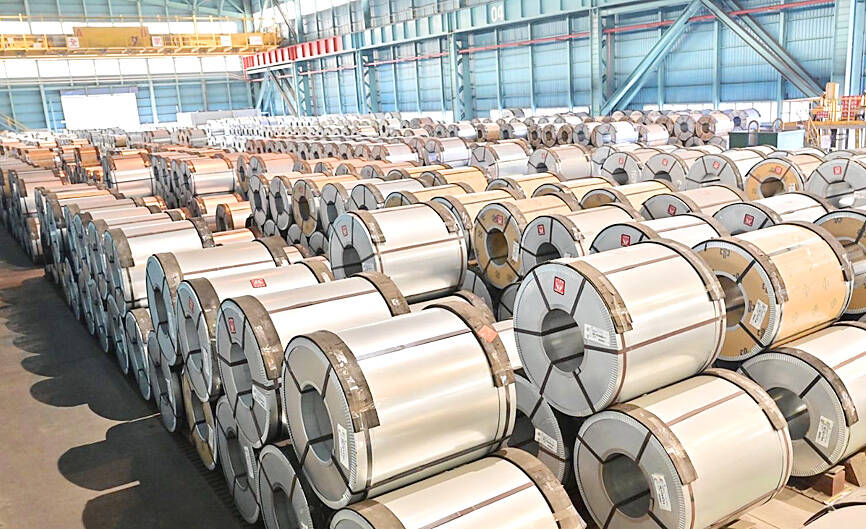China Steel Corp (中鋼) yesterday reported a profit for the first time since September last year, thanks to improving economic prospects following China’s reopening and its doubling down on an infrastructure budget to stimulate economic growth.
The Kaohsiung-based steelmaker said that restocking demand and an uptick in steel prices helped it return to the black last month.
Shipments expanded 15 percent last month to 930,000 tonnes from 800,000 tonnes in January, a company statement said.

Photo courtesy of China Steel Corp
China Steel reported a net profit of NT$69.3 million (US$2.28 million) for last month, after posting a pre-tax loss of NT$1.09 billion in January, the statement said.
However, the company remained in the red in the first two months of the year, with a combined pretax loss of NT$1.02 billion, compared with a pretax profit of NT$9.86 billion a year earlier.
“As the global manufacturing sector is bottoming out, the company expects to see a new round of solid steel demand. That would pave the way for a rebound in global steel prices,” China Steel said in the statement.
“As the second quarter is usually a peak season for the steel industry, we expect to see robust steel demand,” it added.
As a result, China Steel expects its operations to “improve step by step in the second quarter,” the statement said.
The company last week raised local prices in response to improving steel demand and surging raw material costs.
It hiked prices for delivery next month by between NT$800 and NT$1,000 per tonne, while prices for the second quarter as a whole are to rise by NT$1,500 to NT$2,000 per tonne. The price hikes are applicable to almost all products, it said.
Steel products used in the construction and auto manufacturing sectors posted the largest price increases for next month and next quarter.
Hot-rolled steel plates and hot-rolled steel are to increase by NT$1,000 per tonne each next month and by NT$2,000 next quarter.

STIMULUS PLANS: An official said that China would increase funding from special treasury bonds and expand another program focused on key strategic sectors China is to sharply increase funding from ultra-long treasury bonds this year to spur business investment and consumer-boosting initiatives, a state planner official told a news conference yesterday, as Beijing cranks up fiscal stimulus to revitalize its faltering economy. Special treasury bonds would be used to fund large-scale equipment upgrades and consumer goods trade-ins, said Yuan Da (袁達), deputy secretary-general of the Chinese National Development and Reform Commission. “The size of ultra-long special government bond funds will be sharply increased this year to intensify and expand the implementation of the two new initiatives,” Yuan said. Under the program launched last year, consumers can

Citigroup Inc and Bank of America Corp said they are leaving a global climate-banking group, becoming the latest Wall Street lenders to exit the coalition in the past month. In a statement, Citigroup said while it remains committed to achieving net zero emissions, it is exiting the Net-Zero Banking Alliance (NZBA). Bank of America said separately on Tuesday that it is also leaving NZBA, adding that it would continue to work with clients on reducing greenhouse gas emissions. The banks’ departure from NZBA follows Goldman Sachs Group Inc and Wells Fargo & Co. The largest US financial institutions are under increasing pressure

TRENDS: The bitcoin rally sparked by US president-elect Donald Trump’s victory has slowed down, partly due to outflows from exchange-traded funds for the token Gold is heading for one of its biggest annual gains this century, with a 27 percent advance that has been fueled by US monetary easing, sustained geopolitical risks and a wave of purchases by central banks. While bullion has ticked lower since US president-elect Donald Trump’s sweeping victory in last month’s election, its gains this year still outstrip most other commodities. Base metals have had a mixed year, while iron ore has tumbled, and lithium’s woes have deepened. The varied performances highlight the absence of a single, over-riding driver that has steered the complex’s fortunes, while also putting the spotlight

Twenty years after he was a young, struggling actor in Toronto, Thomas Lo (盧瑞麟) is now the one giving young Asian actors their big breaks. He just had to go to Hong Kong to do it. The Chinese Canadian has been the creative director of one of the territory’s biggest TV broadcasting companies for only a few years, but is already making original English-language content to reach viewers around the world. “It was a bit of a full-circle moment for me,” Lo said. “You see more Asians, but you’re still seeing the same Asians on screen, right? We’re looking for more opportunities